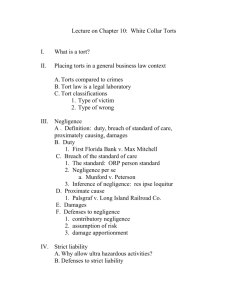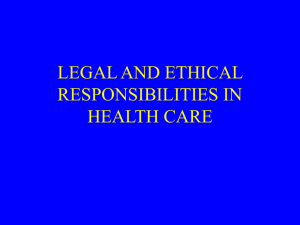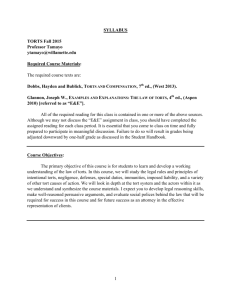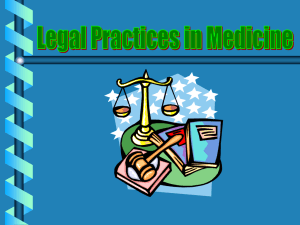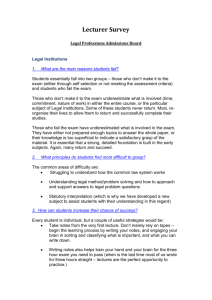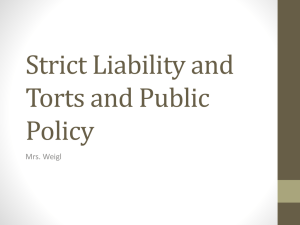Tort Law - Connecticut Regional Vocational
advertisement
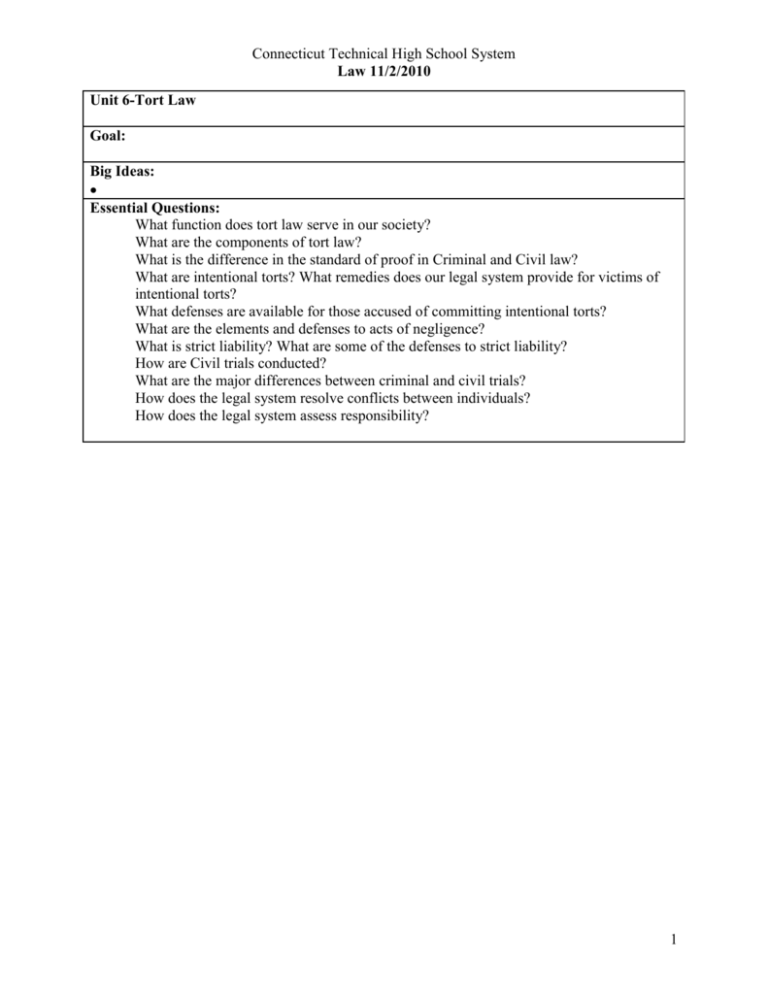
Connecticut Technical High School System Law 11/2/2010 Unit 6-Tort Law Goal: Big Ideas: Essential Questions: What function does tort law serve in our society? What are the components of tort law? What is the difference in the standard of proof in Criminal and Civil law? What are intentional torts? What remedies does our legal system provide for victims of intentional torts? What defenses are available for those accused of committing intentional torts? What are the elements and defenses to acts of negligence? What is strict liability? What are some of the defenses to strict liability? How are Civil trials conducted? What are the major differences between criminal and civil trials? How does the legal system resolve conflicts between individuals? How does the legal system assess responsibility? 1 Connecticut Technical High School System Law 11/2/2010 Learning Outcomes Students will: As evidenced by oral, written, and/or performance: Describe the remedies available under tort law. Explain the concepts of the reasonable person test and proximate cause. Differentiate between criminal and tort law. Differentiate between criminal trials and civil trials. Evaluate and apply tort law to several scenarios. Explain the difference between criminal and civil law standards of guilt. Assess the differences between negligence torts, intentional torts, and strict liability torts. Analyze cases and apply laws. Compare and contrast the steps in a civil law suit with the steps in a criminal prosecution. Describe the adversary system and evaluate its advantages and disadvantages. Describe the civil and criminal justice systems, analyze their operations, and assess their effectiveness. Distinguish similarities and differences in the civil and criminal justice systems. Compare the operations and processes of the civil and criminal justice systems Summarize issues and problems confronting the civil and criminal justice systems and assess the effectiveness of those systems in resolving them. Distinguish between civil and criminal penalties and explain the rationale for each. Apply the standards and remedies for intentional torts. Apply the standards and remedies for negligence. Apply the standards and remedies strict liability torts. Understand how civil and criminal laws are made at the federal, state, and local levels of government and how these laws are 2 Connecticut Technical High School System Law 11/2/2010 employed in the various federal and state courts. 3 Connecticut Technical High School System Law 11/2/2010 Resources: Textbook: Problem 18.1, Torts, p. 214 Problem 18.2, Smoking, p. 217 Problem 18.3, Torts, p. 218 Problem 18.4, Spills, p. 220 Problem 18.5, Airlines, p. 222 Problem 18.6, Steering Wheel, p. 223 Problem 18.7, Insurance, p. 225 Problem 18.9, Non-stop car, p. 226 Problem 18.10, Non-stop car, p. 228 Problem 18.11, School, p. 229 Problem 19.1, Child, p. 231 Problem 19.2, Battery, p. 233 Problem 19.3, Emotional Distress, p. 235 Problem 19.4, Shelter, p. 236 Problem 19.5, Shoplift, p. 237 Problem 19.6, Swim, p. 240 Problem 19.7, Make my day, p. 241 Problem 19.8, Copyright, p. 247 Problem 20.1, Coffee, p. 252 Problem 20.2, Bartend, p. 254 Problem 20.3, AIDS, p. 255 Problem 20.4, Fire, p. 256 Problem 20.5, Prank, p. 257 Problem 20.6, Cigarettes, p. 258 Problem 20.7, Cases, p. 260 Problem 21.1, Cases, p. 262 Problem 21.2, Pesticide, p. 263 Problem 21.3, Dogs, p. 264 Problem 21.4, Dangers, p. 265 Problem 21.5, 1st respond, p. 265 Problem 21.6, Gun-maker, p. 266 Problem 21.7, Defenses, p. 267 Problem 22.1, Nightclub Fire, p. 271 Problem 22.2, Homes, p. 272 Problem 22.3, Driving & Phone, p. 273 Workbook: p. 40-basics p. 41-terms p. 42-intentional torts p. 43-sexually transmitted disease p. 44-strict liability p. 45-strict liability p. 46-tort reform p. 47-48-terms Extension Activity: 4 Connecticut Technical High School System Law 11/2/2010 Formative Assessments TBD Summative District Assessments TBD 5 Connecticut Technical High School System Law 11/2/2010 Concepts Students need to know about: Torts: Introduction The Idea of Liability The Idea of Torts: Yesterday, Today, and Tomorrow Common Law Types of Torts Taking your Case to Court Insurance Types Personal Injury Auto Workers’ Compensation Intentional Torts Types of Damages Torts that Injure Persons Types Battery and Assault Emotional Distress Defamation Libel and Slander Torts that Harm Property Trespass Attractive Nuisances Patents, Trademarks, Copyrights Defenses to Intentional Torts Affirmative Defenses Negligence Elements of Negligence Duty Duty and Breach Reasonable Manner Causation Show Cause Damages Harm Defenses to Negligence Contributory Negligence Comparative Negligence Assumption of Risk Release Waivers Strict Liability Dangerous Activities Unreasonable Dangers Skills Students need to be able to do: 6 Connecticut Technical High School System Law 11/2/2010 Toxic Torts Animals Owner at Risk Dog Bite Statute Inherently Dangerous Animals Defective Products Product Liability Law Defects Safe Products Defenses to Strict Liability Torts and Public Policy Tort Reform Cost of Safety 7

